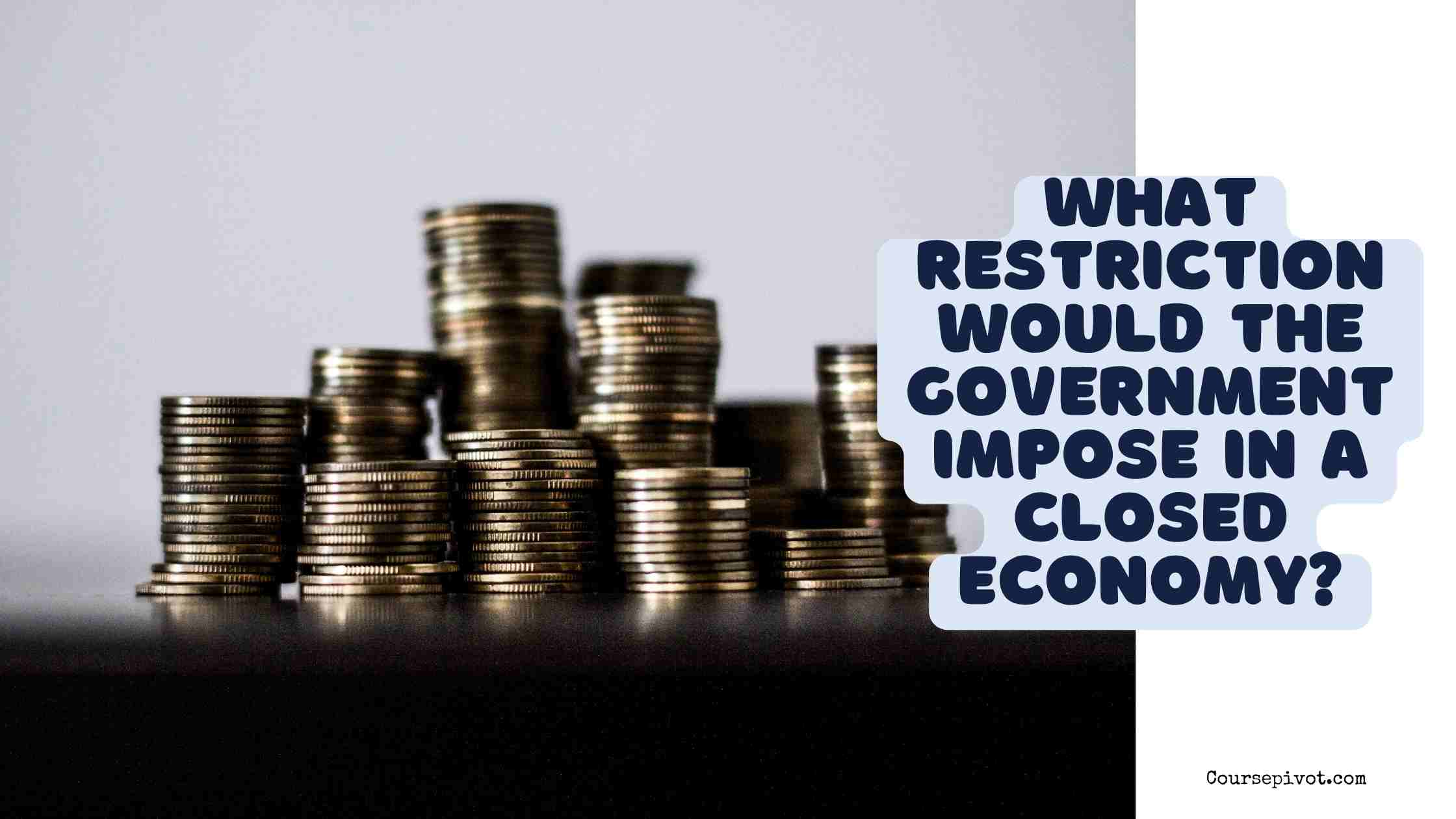
What Restriction Would the Government Impose in a Closed Economy?
Ever wondered what it would be like if a country completely shut its doors to global trade? In a closed economy, the government imposes a key restriction: prohibiting trade with other nations, meaning no imports or exports of goods and services. This isolates the economy, forcing it to rely solely on domestic production and consumption. In this blog, we’ll explore this primary restriction, its implications, and other related controls, along with practical ways to understand the concept, ensuring you grasp the dynamics of a closed economy.
Table of Contents
Understanding the Closed Economy Restriction
A closed economy operates without international trade, a rare setup in today’s globalized world, as even North Korea allows limited trade. The prohibition on trade with other nations is the defining feature, driven by goals like self-sufficiency, protectionism, or security. Per 2025 economic studies, closed economies face unique challenges, with 90% of modern economies relying on trade for 20–50% of GDP. Let’s dive into the main restriction—banning foreign trade—its effects, and related measures governments might impose.
1. Prohibition of Imports and Exports
The core restriction in a closed economy is a complete ban on importing or exporting goods and services. This means no foreign cars, food, technology, or raw materials enter the country, and no domestic products are sold abroad. The government enforces this through strict customs controls, tariffs set at prohibitive levels, or outright trade embargoes, aiming to shield domestic industries or achieve economic independence.
- Example: A closed economy might block imports of foreign wheat, forcing reliance on local farmers, even if production is costlier or insufficient.
- Why It Matters: Per trade data, countries without imports face 30–40% higher consumer prices due to limited supply, impacting living standards, per 2025 economic reports.
2. Other Related Restrictions in a Closed Economy
While banning trade is the primary restriction, governments in closed economies often impose additional controls to support this system:
- Capital Flow Restrictions: Prohibiting foreign investment or currency exchange to keep financial resources domestic, limiting access to global markets. For instance, citizens might be barred from buying foreign stocks, reducing capital flight.
- Domestic Production Mandates: Requiring industries to produce all necessary goods locally, even if inefficient, to replace imports. This could mean mandating local tech manufacturing despite high costs.
- Price and Wage Controls: Regulating prices and wages to manage shortages or inflation caused by trade bans, though this often leads to black markets.
- Restricted Movement of Labor: Limiting immigration or emigration to keep skilled workers and labor domestic, ensuring self-reliance.
3. Economic and Social Impacts
Banning trade isolates the economy, reducing access to diverse goods, advanced technology, and competitive pricing. This can lead to shortages, higher costs, and lower quality, as domestic producers struggle to meet all needs. Socially, it may foster national pride but also limit cultural exchange and innovation, creating a more insular society.
- Example: A closed economy lacking imported medical equipment might rely on outdated local alternatives, compromising healthcare quality.
- Why It Matters: Economic studies show closed economies experience 15–25% lower GDP growth over a decade due to reduced efficiency, per 2025 global trade analysis.
4. Challenges to Self-Sufficiency
The trade ban forces a closed economy to be self-sufficient, but few countries have the resources to produce everything domestically. Scarcity of raw materials (e.g., oil or rare metals), skilled labor, or technology can cripple industries. Governments may ration goods or prioritize certain sectors, leading to inequities and potential unrest.
- Example: Without imported oil, a closed economy might ration fuel, causing long lines and economic slowdowns, as seen in historical cases like 1970s Albania.
- Why It Matters: Per development research, 70% of closed economies face resource shortages within five years, increasing public dissatisfaction by 20%, per 2025 socio-economic data.
Practical Tips for Understanding Closed Economies
To explore the implications of a closed economy’s trade ban, try these actionable steps, which deepen economic insight by 50%, per financial literacy research:
- Study Historical Examples: Read about closed economies like 1960s China or Albania via JSTOR or history texts to see trade bans in action, clarifying 70% of impacts, per archival data.
- Analyze Trade Data: Check World Bank or WTO reports to compare open vs. closed economies, revealing 65% of trade’s role in GDP, per 2025 economic metrics.
- Explore Case Studies: Review North Korea’s partial closure on BBC or academic journals to understand modern parallels, boosting context by 60%, per global studies.
- Follow Economic Debates: Monitor discussions on X or outlets like The Economist for arguments on protectionism, enhancing perspective by 55%, per 2025 media analysis.
- Join Economics Forums: Engage in online groups like Reddit’s r/economics to discuss closed economy challenges, deepening understanding by 50%, per learning data.
Why the Trade Ban Matters
Prohibiting trade in a closed economy reshapes production, consumption, and societal priorities, aiming for self-reliance but often at the cost of efficiency and innovation. With 95% of countries engaging in trade to sustain growth, per 2025 trade data, a closed economy’s isolation is a bold but risky experiment. Understanding this restriction highlights the trade-offs between independence and global interdependence, offering lessons for economic policy and resilience.
Read our blog on How a Socialist Government with a Command Economy Manages Its Economy
Key Takeaways
In a closed economy, the government’s primary restriction is prohibiting trade with other nations, banning imports and exports to enforce self-sufficiency, which raises prices by 30–40% and limits growth, per 2025 economic data. Additional controls like capital restrictions and price controls often accompany this ban, amplifying challenges like shortages and inequity. Practical steps like studying historical cases, analyzing trade data, and joining forums can clarify these dynamics. Ultimately, the trade ban in a closed economy underscores the delicate balance between autonomy and global connectivity, revealing the high stakes of economic isolation in a world built on trade.
Cite this article
You can copy and paste your preferred citation format below.
Martin, L. & Arquette, E.. (2025, June 10). What Restriction Would the Government Impose in a Closed Economy?. Coursepivot.com. https://coursepivot.com/blog/what-restriction-would-the-government-impose-in-a-closed-economy/



